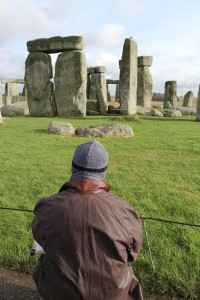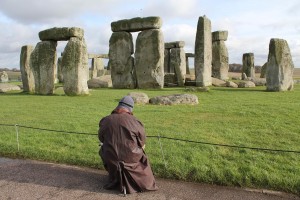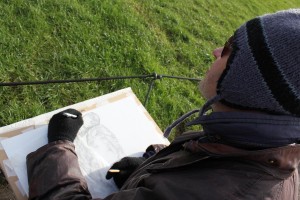Stonehenge – Friday 1st February
The journey up to Stonehenge feels a little like traversing a war zone, not this time because of military activity, but because of the road works happening around the new visitor centre build. I suppose they’re doing well to keep the roads open at all considering everything that’s going on here. The route is a jumble of trenches and traffic cones, ripped tarmac and temporary traffic lights.
The glossy hoardings along the roadside announce ‘Stonehenge: A New Dawn’ – but apparently we have to wait until Winter 2013 for the sun to rise.
February is introducing herself quite charmingly. The light is glorious, the skies a polite patchwork of cloud and the temperature reasonably mild. There is though a sharpness in the wind, a reminder that it really is still winter.
The walkways around the stone circle are half open. We can walk along the tarmac path and the path along the chain-link fence to the Heel Stone, but the grass is out of bounds, still sodden from the rain and the snowmelt and the most recent rain.
An Apache helicopter flies low along the Cursus. I can recognise these now since they’ve had so much TV coverage. The British broadcasters have sought to illuminate the public on the activities of our youngest Prince and he flies one of these. They’re identifiable from the top-knot immediately above the blades. There’s also a fighter jet flying high directly above the stone circle, but I don’t know what it is, what it’s called. It looks like a dart, an echo of an ancient arrowhead.
Mark is still working on his silverpoint trilithon. The weather has been so foul of late he’s not been able to draw up here as often as he would have liked. He actually needs a little tent; one of those shelters fishermen use to sit inside while waiting for a bite, but I don’t think English Heritage would approve. He’s persevering though.
The visitors pose next to the guide rope, as ever, visitors from a multitude of countries. I hear a man, American or Canadian, ask one of the staff if they can tell him something about Ley Lines. “Can you see them on the ground?” he asks, scouring the grassy areas of the Henge.
A man in a knitted hat stands next to Mark peering over at his drawing, then starts talking to him. I’m not close enough to eavesdrop, but he’s obviously asking serious questions or making points that are of interest to Mark because he’s staying there. I know he’s not rude to people, but Mark has developed a quiet knack of discouraging people who are just disturbing him.
A woman in a maroon raincoat stands at the end of the tarmac path with her small compact camera and says, “It’s quite something isn’t it?”
I’m the only person nearby so feel it would be rude to ignore such enthusiasm. This is a wonderful thing that tourists share, the mutual discovery of something new. It bonds us as travellers. And although I’ve been visiting Stonehenge now for over seven months, I still feel the thrill of that encounter with the stones and the thrill of the shared experience. This lady is travelling from London to a celebration in Wells and rather than driving straight past has stopped off en route to get a closer look at Stonehenge. We have a wonderful chat and she quotes a piece of T.S. Eliot that comes to mind as she contemplates this place, and the stones, and the feet of all those who’ve journeyed here and their desire to share in something significant or, to simply honour this place; they’ve come “to kneel where prayer has been valid”.
And there’s a gift for the day, a reminder of the brilliance of T.S. Eliot and that there’s a volume of his poetry on our bookshelves just waiting to be reopened.
T.S. Eliot – Four Quartets. (from) Little Gidding – I
‘If you came this way,
Taking any route, starting from anywhere,
At any time or at any season,
It would always be the same: you would have to put off
Sense and notion. You are not here to verify,
Instruct yourself, or inform curiosity
Or carry report. You are here to kneel
Where prayer has been valid. And prayer is more
Than an order of words, the conscious occupation
Of the praying mind, or the sound of the voice praying.
And what the dead had no speech for, when living,
They can tell you, being dead: the communication
Of the dead is tongued with fire beyond the language of the living.
Here, the intersection of the timeless moment
Is England and nowhere. Never and always.’


